Seat Alhambra 2015 Owner's Guide
Manufacturer: SEAT, Model Year: 2015, Model line: Alhambra, Model: Seat Alhambra 2015Pages: 305, PDF Size: 5.46 MB
Page 31 of 305

Transporting children safely
the most protection possible for babies and
small children in most accidents. Note
Other accessories may be required to fit the
child retention system with a base or foot se- curity and safely. Contact a technical service
centre or specialised workshop.
Different mounting systems
Fig. 25
On the rear seats: Possible installations for the child seat. Always secure child seats properly and safely
in the vehicle according to the child seat
manufacturer's installation instructions.
Mounted child seats must rest correctly on
the vehicle's seat and must not move or rock
more than 2.5 cm (1 inch).
Child seats equipped for a Top Tether strap
must also be secured using the Top Tether re-
taining strap in the vehicle
››› page 32. Only
secure the retaining belt to the rings fitted for
this purpose and identified as Top Tether.
Not all rings can be used with the Top Tether system. Always tighten the Top Tether retain-
ing strap so that the child seat fits snugly
against the corresponding seat in the vehi-
cle.
Specific mounting systems for each country
Europe : ISOFIX retaining rings and upper
r et
aining strap ››› page 32 and
››› page 32.
Three-point
seat belt and upper retaining
strap ››› page 31
.
A B The systems include the child restraint sys-
tem mounting with an upper retaining strap
(Top Tether) and lower anchoring points on
the seat.
Use of the child seat on the front
passenger seat Transporting children on the front passenger
seat is not permitted in all countries. Further-
more, not all child seats are approved for use
on the front passenger seat. Your technical
»
29
Technical specifications
Advice
Operation
Safety
Page 32 of 305
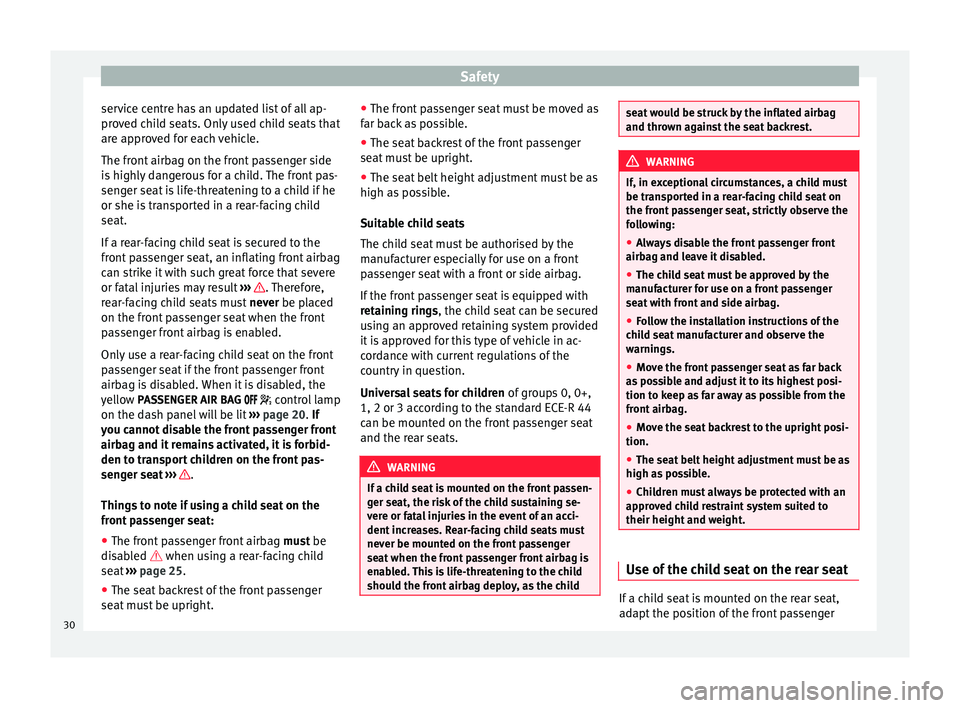
Safety
service centre has an updated list of all ap-
proved child seats. Only used child seats that
are approved for each vehicle.
The front airbag on the front passenger side
is highly dangerous for a child. The front pas-
senger seat is life-threatening to a child if he
or she is transported in a rear-facing child
seat.
If a rear-facing child seat is secured to the
front passenger seat, an inflating front airbag
can strike it with such great force that severe
or fatal injuries may result ››› . Therefore,
rear-facing child seats must never be placed
on the fr ont
passenger seat when the front
passenger front airbag is enabled.
Only use a rear-facing child seat on the front
passenger seat if the front passenger front
airbag is disabled. When it is disabled, the
yellow PASSENGER AIR BAG control lamp
on the dash panel will be lit ››› page 20. If
you cannot disable the front passenger front
airbag and it remains activated, it is forbid-
den to transport children on the front pas-
senger seat ››› .
Things to note if using a child seat on the
front passenger seat:
● The front passenger front airbag must be
disabled when using a rear-facing child
seat ››› page 25 .
● The se at
backrest of the front passenger
seat must be upright. ●
The front passenger seat must be moved as
far back as possible.
● The seat backrest of the front passenger
seat must be upright.
● The seat belt height adjustment must be as
high as possible.
Suitable child seats
The child seat must be authorised by the
manufacturer especially for use on a front
passenger seat with a front or side airbag.
If the front passenger seat is equipped with
retaining rings, the child seat can be secured
us
ing an approved retaining system provided
it is approved for this type of vehicle in ac-
cordance with current regulations of the
country in question.
Universal seats for children of groups 0, 0+,
1, 2 or 3 according to the standard ECE-R 44
can be mounted on the front passenger seat
and the rear seats. WARNING
If a child seat is mounted on the front passen-
ger seat, the risk of the child sustaining se-
vere or fatal injuries in the event of an acci-
dent increases. Rear-facing child seats must
never be mounted on the front passenger
seat when the front passenger front airbag is
enabled. This is life-threatening to the child
should the front airbag deploy, as the child seat would be struck by the inflated airbag
and thrown against the seat backrest.
WARNING
If, in exceptional circumstances, a child must
be transported in a rear-facing child seat on
the front passenger seat, strictly observe the
following:
● Always disable the front passenger front
airbag and leave it disabled.
● The child seat must be approved by the
manufacturer for use on a front passenger
seat with front and side airbag.
● Follow the installation instructions of the
child seat manufacturer and observe the
warnings.
● Move the front passenger seat as far back
as possible and adjust it to its highest posi-
tion to keep as far away as possible from the
front airbag.
● Move the seat backrest to the upright posi-
tion.
● The seat belt height adjustment must be as
high as possible.
● Children must always be protected with an
approved child restraint system suited to
their height and weight. Use of the child seat on the rear seat
If a child seat is mounted on the rear seat,
adapt the position of the front passenger
30
Page 33 of 305
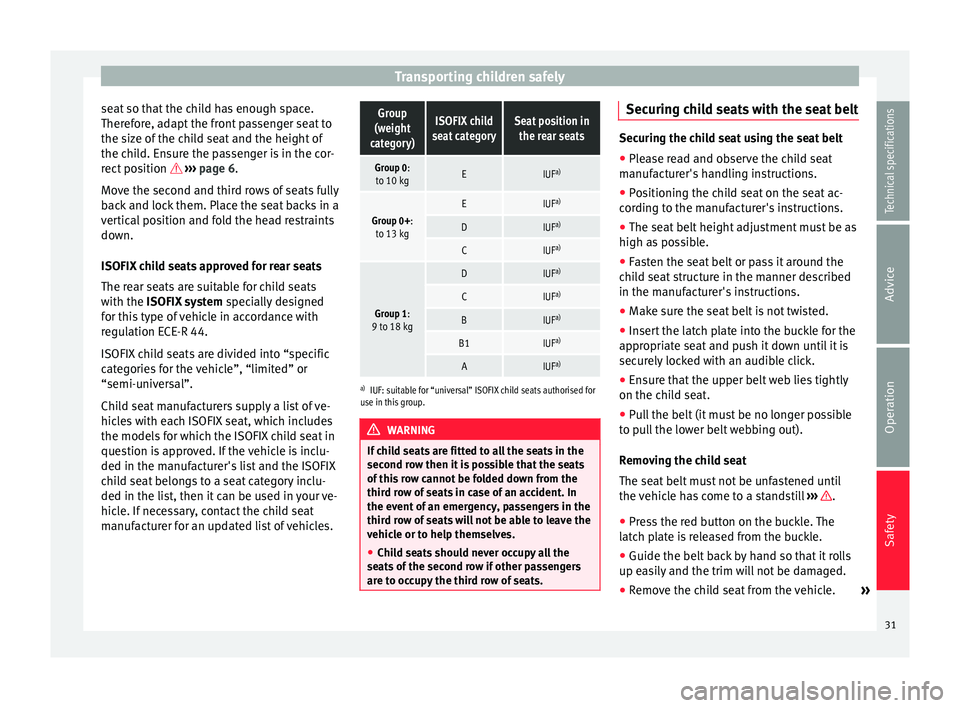
Transporting children safely
seat so that the child has enough space.
Therefore, adapt the front passenger seat to
the size of the child seat and the height of
the child. Ensure the passenger is in the cor-
rect position
›
›› page 6.
Move the second and third rows of seats fully
back and lock them. Place the seat backs in a
vertical position and fold the head restraints
down.
ISOFIX child seats approved for rear seats
The rear seats are suitable for child seats
with the ISOFIX system spec
ially designed
for this type of vehicle in accordance with
regulation ECE-R 44.
ISOFIX child seats are divided into “specific
categories for the vehicle”, “limited” or
“semi-universal”.
Child seat manufacturers supply a list of ve-
hicles with each ISOFIX seat, which includes
the models for which the ISOFIX child seat in
question is approved. If the vehicle is inclu-
ded in the manufacturer's list and the ISOFIX
child seat belongs to a seat category inclu-
ded in the list, then it can be used in your ve-
hicle. If necessary, contact the child seat
manufacturer for an updated list of vehicles.
Group
(weight
category)ISOFIX child
seat categorySeat position in the rear seats
Group 0:to 10 kgEIUF a)
Group 0+:
to 13 kgEIUF a)
DIUFa)
CIUFa)
Group 1:
9 to 18 kg
DIUF a)
CIUFa)
BIUFa)
B1IUFa)
AIUFa)
a)
IUF: suitable for “universal” ISOFIX child seats authorised for
use in this group. WARNING
If child seats are fitted to all the seats in the
second row then it is possible that the seats
of this row cannot be folded down from the
third row of seats in case of an accident. In
the event of an emergency, passengers in the
third row of seats will not be able to leave the
vehicle or to help themselves.
● Child seats should never occupy all the
seats of the second row if other passengers
are to occupy the third row of seats. Securing child seats with the seat belt
Securing the child seat using the seat belt
● Please read and observe the child seat
manufacturer's handling instructions.
● Positioning the child seat on the seat ac-
cording to the manufacturer's instructions.
● The seat belt height adjustment must be as
high as possible.
● Fasten the seat belt or pass it around the
child seat structure in the manner described
in the manufacturer's instructions.
● Make sure the seat belt is not twisted.
● Insert the latch plate into the buckle for the
appropriate seat and push it down until it is
securely locked with an audible click.
● Ensure that the upper belt web lies tightly
on the child seat.
● Pull the belt (it must be no longer possible
to pull the lower belt webbing out).
Removing the child seat
The seat belt must not be unfastened until
the vehicle has come to a standstill ››› .
● Press the red button on the buckle. The
latch plate is released from the buckle.
● Guide the belt back by hand so that it rolls
up easily and the trim will not be damaged.
● Remove the child seat from the vehicle. »
31
Technical specifications
Advice
Operation
Safety
Page 34 of 305
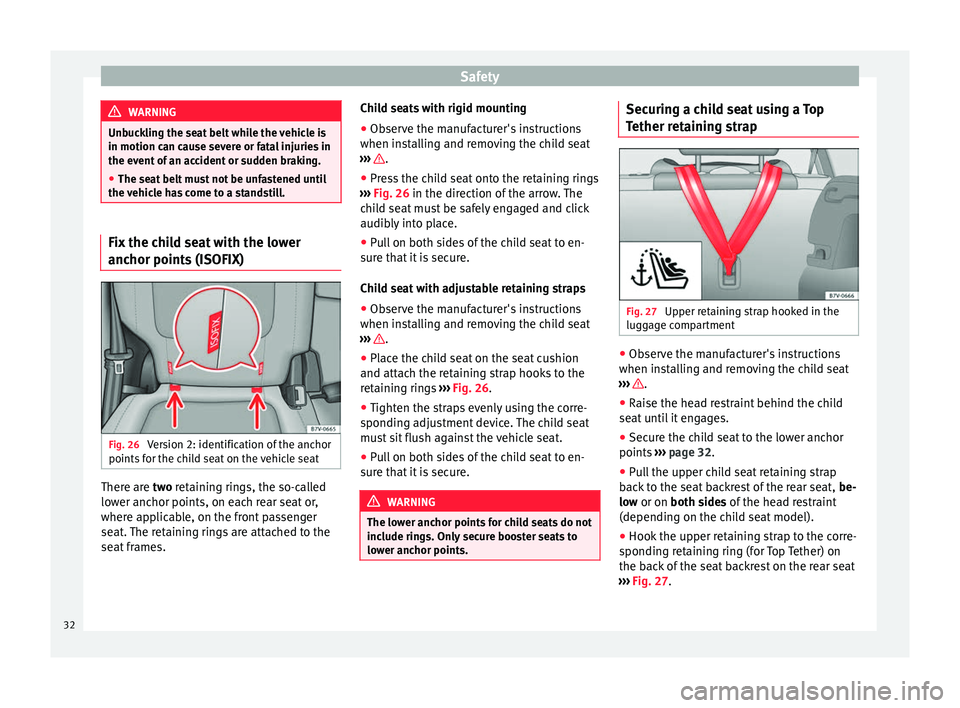
Safety
WARNING
Unbuckling the seat belt while the vehicle is
in motion can cause severe or fatal injuries in
the event of an accident or sudden braking.
● The seat belt must not be unfastened until
the vehicle has come to a standstill. Fix the child seat with the lower
anchor points (ISOFIX)
Fig. 26
Version 2: identification of the anchor
points for the child seat on the vehicle seat There are
two
retaining rings, the so-called
lo
wer anchor points, on each rear seat or,
where applicable, on the front passenger
seat. The retaining rings are attached to the
seat frames. Child seats with rigid mounting
● Observe the manufacturer's instructions
when installing and removing the child seat
››› .
● Press the child seat onto the retaining rings
››› Fig. 26 in the direction of the arrow. The
c hi
ld seat must be safely engaged and click
audibly into place.
● Pull on both sides of the child seat to en-
sure that it is secure.
Child seat with adjustable retaining straps
● Observe the manufacturer's instructions
when installing and removing the child seat
››› .
● Place the child seat on the seat cushion
and attach the retaining strap hooks to the
retaining rings ››› Fig. 26 .
● Tight en the s
traps evenly using the corre-
sponding adjustment device. The child seat
must sit flush against the vehicle seat.
● Pull on both sides of the child seat to en-
sure that it is secure. WARNING
The lower anchor points for child seats do not
include rings. Only secure booster seats to
lower anchor points. Securing a child seat using a Top
Tether retaining strap
Fig. 27
Upper retaining strap hooked in the
luggage compartment ●
Observe the manufacturer's instructions
when installing and removing the child seat
››› .
● Raise the head restraint behind the child
seat until it engages.
● Secure the child seat to the lower anchor
points ››› page 32 .
● Pu
ll the upper child seat retaining strap
back to the seat backrest of the rear seat, be-
low or on both sides
of the head restraint
(depending on the child seat model).
● Hook the upper retaining strap to the corre-
sponding retaining ring (for Top Tether) on
the back of the seat backrest on the rear seat
››› Fig. 27.
32
Page 35 of 305
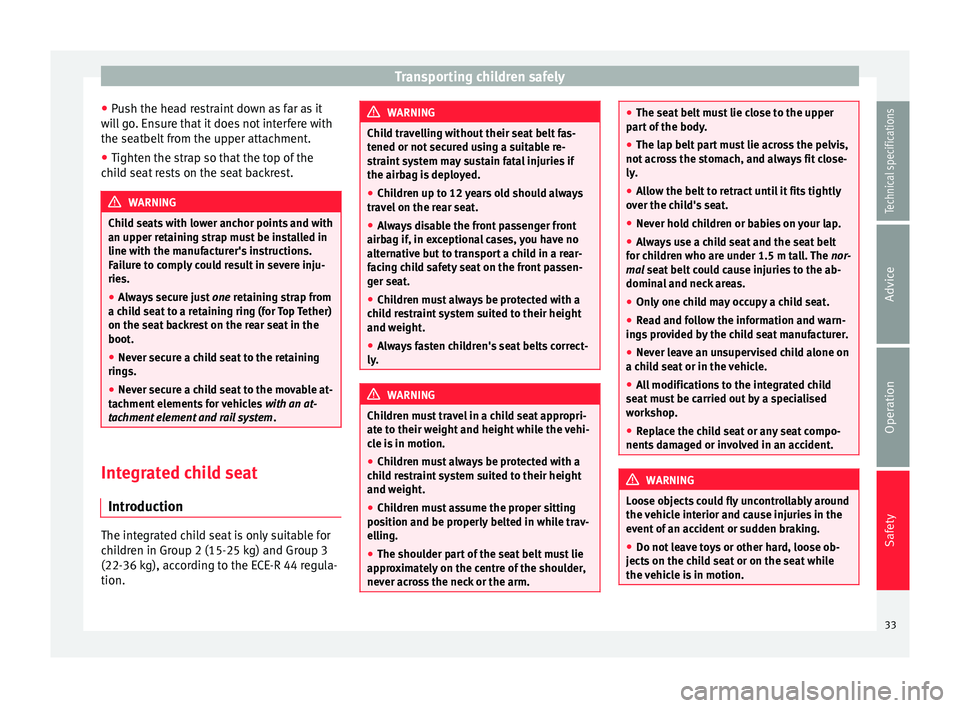
Transporting children safely
● Push the head restraint down as far as it
will go. Ensure that it does not interfere with
the seatbelt from the upper attachment.
● Tighten the strap so that the top of the
child seat rests on the seat backrest. WARNING
Child seats with lower anchor points and with
an upper retaining strap must be installed in
line with the manufacturer's instructions.
Failure to comply could result in severe inju-
ries.
● Always secure just one retaining strap from
a c hi
ld seat to a retaining ring (for Top Tether)
on the seat backrest on the rear seat in the
boot.
● Never secure a child seat to the retaining
rings.
● Never secure a child seat to the movable at-
tachment elements for vehicles with an at-
tachment element and rail system .Integrated child seat
Introduction The integrated child seat is only suitable for
children in Group 2 (15-25 kg) and Group 3
(22-36 kg), according to the ECE-R 44 regula-
tion. WARNING
Child travelling without their seat belt fas-
tened or not secured using a suitable re-
straint system may sustain fatal injuries if
the airbag is deployed.
● Children up to 12 years old should always
travel on the rear seat.
● Always disable the front passenger front
airbag if, in exceptional cases, you have no
alternative but to transport a child in a rear-
facing child safety seat on the front passen-
ger seat.
● Children must always be protected with a
child restraint system suited to their height
and weight.
● Always fasten children's seat belts correct-
ly. WARNING
Children must travel in a child seat appropri-
ate to their weight and height while the vehi-
cle is in motion.
● Children must always be protected with a
child restraint system suited to their height
and weight.
● Children must assume the proper sitting
position and be properly belted in while trav-
elling.
● The shoulder part of the seat belt must lie
approximately on the centre of the shoulder,
never across the neck or the arm. ●
The seat belt must lie close to the upper
part of the body.
● The lap belt part must lie across the pelvis,
not across the stomach, and always fit close-
ly.
● Allow the belt to retract until it fits tightly
over the child's seat.
● Never hold children or babies on your lap.
● Always use a child seat and the seat belt
for children who are under 1.5 m tall. The nor-
mal seat belt could cause injuries to the ab-
domin a
l and neck areas.
● Only one child may occupy a child seat.
● Read and follow the information and warn-
ings provided by the child seat manufacturer.
● Never leave an unsupervised child alone on
a child seat or in the vehicle.
● All modifications to the integrated child
seat must be carried out by a specialised
workshop.
● Replace the child seat or any seat compo-
nents damaged or involved in an accident. WARNING
Loose objects could fly uncontrollably around
the vehicle interior and cause injuries in the
event of an accident or sudden braking.
● Do not leave toys or other hard, loose ob-
jects on the child seat or on the seat while
the vehicle is in motion. 33
Technical specifications
Advice
Operation
Safety
Page 36 of 305

Safety
Unfolding the integrated child seat Fig. 28
Integrated child seats. lift up the
cushion Fig. 29
Integrated child seats. position the
head restraint over the side head restraint A
and fit into place B. The integrated child seat can be fitted with a
side head restraint. SEAT recommends al-
ways using the integrated child seat with the
side head restraint fitted and only using it for
children above the age of 3.Lifting the cushion
● Pull the unlock lever ››› Fig. 28 A on the
cushion in the direction of the arrow
››› Fig. 28 1 .
● Fold both sides ››› Fig. 28 B up in the di-
rection of the arrow ››› Fig. 28 2 .
● Push the cushion ››› Fig. 28 C back in the
direction of the arrow ››› Fig. 28 3 until it en-
gages.
Fitting the side head restraint
● Fold the seat backrest of the rear seat for-
wards ››› page 93 .
● Remo
ve the head restraint.
● Make sure the belt guide handle on the
window side is on the side head restraint
››› page 35.
● Inser
t the guide rods ››› Fig. 29 A 1 of the
head restraint into the guides on the side
head restraint ››› Fig. 29 2 .
● Insert the head restraint and the side head
restraint into the guides on the correspond-
ing seat backrest ››› Fig. 29
B
.
● Push the head restraint down as far as it
will go.
● Fold the seat backrest of the rear seat back.
● Pull the rear seat and the seat backrest to
check whether they are engaged properly.
34
Page 37 of 305
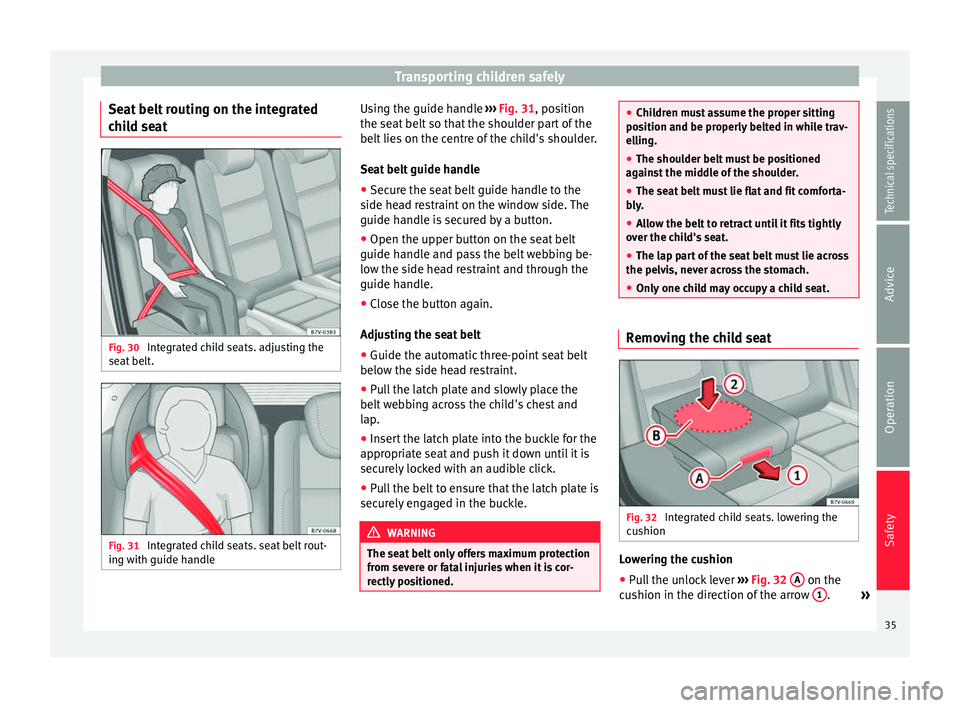
Transporting children safely
Seat belt routing on the integrated
child seat Fig. 30
Integrated child seats. adjusting the
seat belt. Fig. 31
Integrated child seats. seat belt rout-
ing with guide handle Using the guide handle
››› Fig. 31 , position
the se at
belt so that the shoulder part of the
belt lies on the centre of the child's shoulder.
Seat belt guide handle
● Secure the seat belt guide handle to the
side head restraint on the window side. The
guide handle is secured by a button.
● Open the upper button on the seat belt
guide handle and pass the belt webbing be-
low the side head restraint and through the
guide handle.
● Close the button again.
Adjusting the seat belt
● Guide the automatic three-point seat belt
below the side head restraint.
● Pull the latch plate and slowly place the
belt webbing across the child's chest and
lap.
● Insert the latch plate into the buckle for the
appropriate seat and push it down until it is
securely locked with an audible click.
● Pull the belt to ensure that the latch plate is
securely engaged in the buckle. WARNING
The seat belt only offers maximum protection
from severe or fatal injuries when it is cor-
rectly positioned. ●
Children must assume the proper sitting
position and be properly belted in while trav-
elling.
● The shoulder belt must be positioned
against the middle of the shoulder.
● The seat belt must lie flat and fit comforta-
bly.
● Allow the belt to retract until it fits tightly
over the child's seat.
● The lap part of the seat belt must lie across
the pelvis, never across the stomach.
● Only one child may occupy a child seat. Removing the child seat
Fig. 32
Integrated child seats. lowering the
cushion Lowering the cushion
● Pull the unlock lever ››› Fig. 32 A on the
cushion in the direction of the arrow 1 .
»
35
Technical specifications
Advice
Operation
Safety
Page 38 of 305
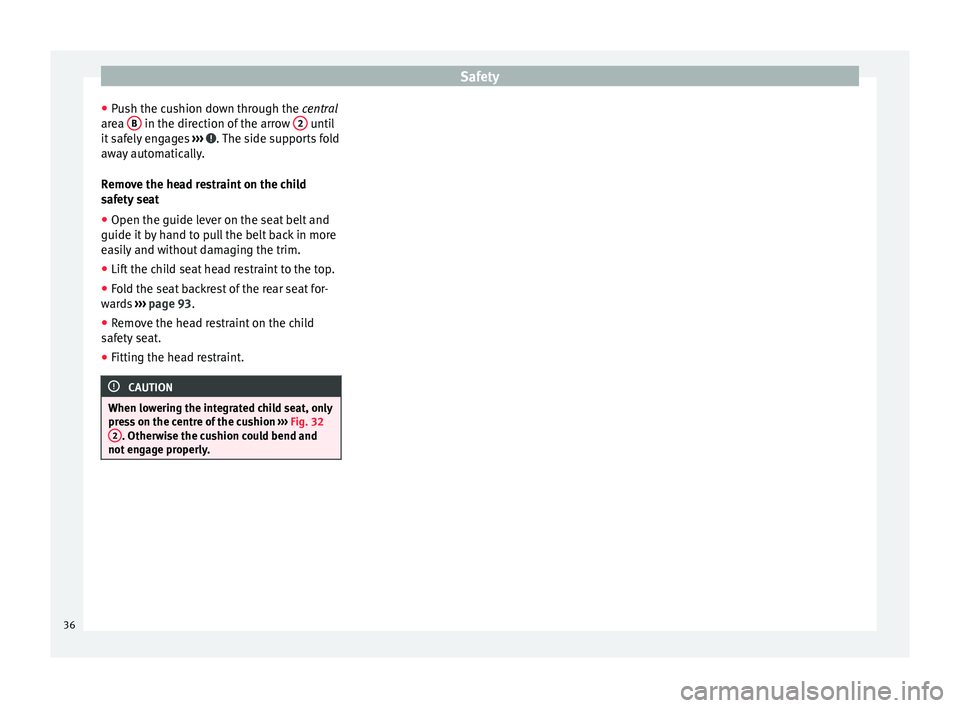
Safety
● Push the cushion down through the central
area B in the direction of the arrow
2 until
it safely engages ››› . The side supports fold
away automatically.
Remove the head restraint on the child
safety seat
● Open the guide lever on the seat belt and
guide it by hand to pull the belt back in more
easily and without damaging the trim.
● Lift the child seat head restraint to the top.
● Fold the seat backrest of the rear seat for-
wards ››› page 93 .
● Remo
ve the head restraint on the child
safety seat.
● Fitting the head restraint. CAUTION
When lowering the integrated child seat, only
press on the centre of the cushion ››› Fig. 32
2 . Otherwise the cushion could bend and
not engage properly. 36
Page 39 of 305

Page 40 of 305
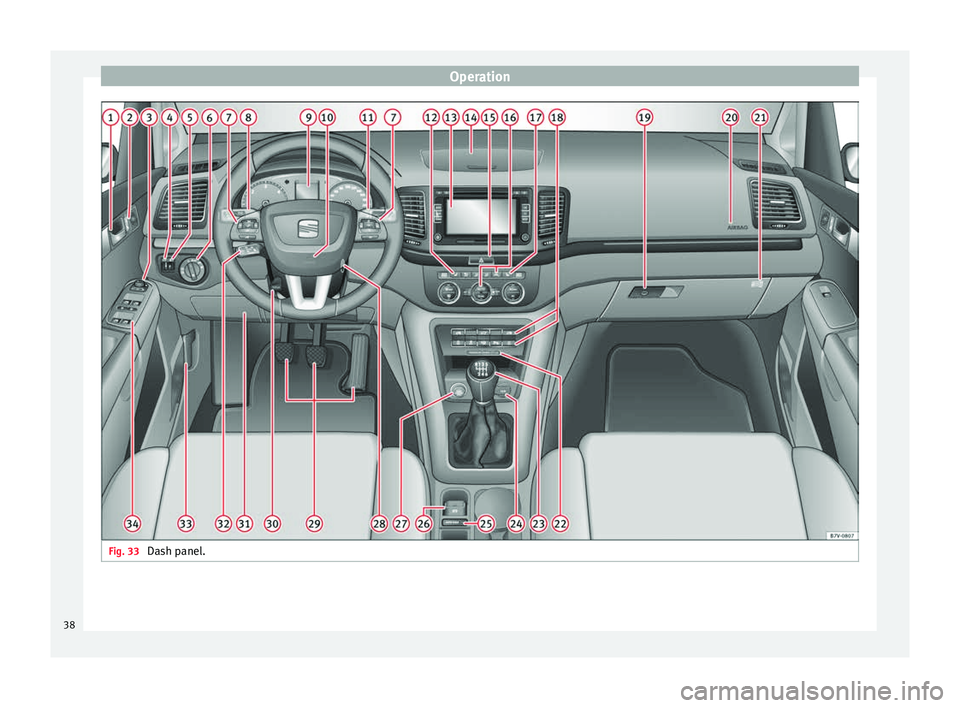
Operation
Fig. 33
Dash panel.38